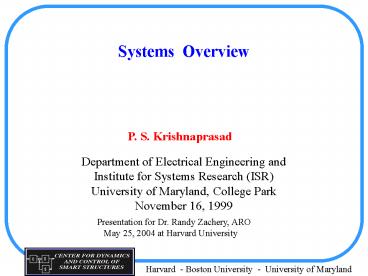Systems Overview - PowerPoint PPT Presentation
Title:
Systems Overview
Description:
Systems Overview P. S. Krishnaprasad Department of Electrical Engineering and Institute for Systems Research (ISR) University of Maryland, College Park November 16, 1999 – PowerPoint PPT presentation
Number of Views:152
Avg rating:3.0/5.0
Title: Systems Overview
1
Systems Overview
P. S. Krishnaprasad
Department of Electrical Engineering and
Institute for Systems Research (ISR) University
of Maryland, College Park November 16, 1999
Presentation for Dr. Randy Zachery, ARO May
25, 2004 at Harvard University
2
Mission Statement
To advance the state-of-the-art in active control
of materials and structures via first-principles
modeling, analysis and computation
To enhance the theoretical foundations of
controlled fluid-structure interactions at
various length scales
To develop the communications and hierarchical
control theory needed for controlling very large
arrays of sensors and actuators
To develop engineering tools for the design and
fabrication of actuators and sensors based on
controllable materials and for the integration of
such devices in structures
3
MARYLAND TEAM
Faculty Stuart Antman, John Baras, P. S.
Krishnaprasad
Post-docs Dimitrios Hristu, Eric Justh, Ram
Venkataraman
Graduate Student Team Sean Andersson, Babak
Azimi-Sadjadi, George Kantor, Andrew Newman,
Jin-Qiu Shao, Xiaobo Tan, Fumin Zhang
Recent Ph.D. graduates Herbert Struemper (1997),
Vikram Manikonda (1997), Eric Justh (1998), Ram
Venkataraman (1999)
ARL Collaborator Mikhail Vorontsov
4
GRADUATE EDUCATION
Ph.D. students
Herbert Struemper (1997), Caltech postdoc, now
Entelos Vikram Manikonda (1997), now
Intelligent Automation Eric Justh (1998),
UMd-ARL postdoc Ram Venkataraman (1999), UMd
postdoc George Kantor (1999),
CMU Field Robotics staff Andrew Newman (1999),
to be Alphatech staff.
5
UNDERGRADUATE EDUCATION
Summer 1998 NSF-REU - Miriam Betnun (MIT '01)
vibratory piezo-motor
Summer 1999 NSF-REU - Charles Brubaker
(Swarthmore '02),
Jacqueline Cockrell (Columbia
'02), motion-control integration Shariar
Chaudhury (Nebraska '02),
Stephanie Wojtkowski
(Swarthmore '02)
Summer 1999 NSF-MERIT - Jonathan Wu (RPI),
Mohammd Jalloh (George Washington),
GPS-integrated motion control Joon-Hoo Lee
(Penn State),
Norman Lo (UMd), all
junior/senior
6
COURSES
A year-long joint course on Analytic and
Geometric Approaches to Classical Mechanics and
Control Theory, cross-listed between Electrical
Engineering and Applied Mathematics (Fall 1997
and Spring 1998) - taught by Antman and
Krishnaprasad
Course for high school students during Summer
1998 on sensors and actuators
- taught by Babak Azimi-Sadjadi
Course for NSF-REU students during Summer 1999 on
Linear algebra and applications to robot
kinematics and control
- taught by Ram Venkataraman
7
OUTREACH
Sharing data and methodology with ETREMA
(hysteresis modeling)
Control and Dynamical Systems Invited Lecture
Series
http//www.isr.umd.edu/Labs/ISL/events.html
8
CURRENT EXTERNAL SUPPORT
CDCSS - Center from Dynamics and Control of Smart
Structures (ARO MURI97)
CAAR - Center for Auditory and Acoustics
Research (ONR MURI97)
LIS - Learning and Intelligent Systems
Learning Binaurally Directed
Movement (NSF97)
9
The Intelligent Servosystems Lab is organized to
advance the state-of-the art in the design and
real-time control of smart systems focusing on
advances in
Novel sensing and actuation materials and
mechanism designs
New principles for actuation, propulsion,
detection, reduction, learning and adaptation
Conceptualizing and prototyping across scales, to
sense, actuate, communicate and control
MURI funds lead to enhancement (e.g. dSPACE
prototyping system)
10
(No Transcript)
11
Smart structures are actively controlled systems
with
coordination of actuation and sensing via
parallel distributed arrays e.g.,
mobile robot with multiple sensors (MEMS
microphones/sonar/GPS)
adaptive optics (LCLV, micromirrors)
remote (wireless) actuation and sensing afford
new challenges
12
MOTION CONTROL INTEGRATION
13
GPS - INTEGRATED CONTROL
14
OUR FOCUS
Understand and exploit nonlinearity
Understand and exploit distributed computation
and control
15
Low-order mathematical models of hysteresis
nonlinearity (in magnetostrictive actuators) for
prediction of performance and real-time control.
Meso-scale actuators based on these materials
(Terfenol-D) are expected to be useful in control
surfaces of aircraft, rotorcraft, and
submersibles.
1.
New techniques for high resolution optical phase
distortion suppression (correcting for the
effects of atmospheric turbulence on laser beams)
have been developed and tested in
simulations. Experimental verification using
liquid crystal light valve actuators are under
way at the Intelligent Optics Laboratory of the
Army Research Lab (ARL). This effort is in
collaboration with Dr. Mikhail Vorontsov of ARL.
Potential additional applications of this work
include optical phase microscopy and wavefront
sensing for conventional adaptive optics systems.
2.
16
New control theory based on pattern formation and
communication/computation pattern selection has
been developed to realize the potential of the
MEMS-scale component technology.
3.
New algorithms for principled reduction of
complex nonlinear models have been developed and
tested. Techniques for approximate inversion of
nonlinear systems for trajectory tracking have
been devised in the setting of systems on Lie
groups. Related controllability results of use in
models that include autonomous ground vehicles
have been obtained.
4.
17
Models of magnetoelastic systems based on the
Landau- Lifshitz-Gilbert equations have been
investigated from a fundamental mathematical
viewpoint as well as from the perspective of
numerical computations. Effective predictions of
hysteresis curves have been realised setting the
stage for a computational actuator design
framework based on first-principles models.
5.
Refined dissipation models of importance to
numerics have been developed in the context of
electro-magneto-solid mechanics. These steps are
paving the way for robust software tools for
design of actuators.
6.
18
Magnetostrictive models (hysteresis/validation/con
trol)
Hysteresis and Numerics (Landau-Lifshitz-Gilbert)
Adaptive Optics (wavefront control)
Patterns and Control (distributed computation and
control)
19
Exploit the opportunities for (wireless)
integrated control in a distributed setting
Applications to fluid structure interaction
20
Develop fully the path from models to software
tools
Extend results on magnetoelastic models to thin
film MEMS-scale actuators and sensors
Advancement of Zernike filter approach to
adaptive optics
Invention disclosure, alternative
implementations (e.g. LCLV vs micromirror), and
hardware integration































